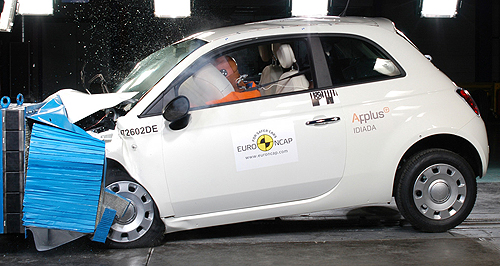Make / Model Search
News - General News - SafetyANCAP shake-up to push vehicle safety forwardBest before: In addition to testing active safety systems of vehicles in 2018, ANCAP will also add an expiration date to its results that will remain applicable for six years. Active safety, readjusted crash testing to be assessed by ANCAP in 201814 May 2018 THE Australasian New Car Assessment Program (ANCAP) will introduce new test procedures to ensure it remains relevant to the ever-growing new-car market and to keep manufacturers from becoming complacent.
As part of a five-year agreement with the federal government, ANCAP has secured $1.3 million per year – up from $1.1m – to expand its assessment of new vehicles, despite continuing to rely on Euro NCAP for half of its ratings.
Although some critics have argued that ANCAP should only have existed while Australia had a local automotive industry, ANCAP chief executive James Goodwin said that it would be foolish to close the operations and rely on Euro NCAP data.
“ANCAP has always been about the local market, not about the local industry,” he told GoAuto at an event at the federal government-funded Crashlab in Sydney last week.
“We have different buying preferences and different demographics than what Europe might have. So about half our ratings are derived from data that we capture from Euro NCAP. But they only account of 25 per cent of the sales volume because they are those luxury premium vehicles.
“If we just relied on Euro NCAP and Australia shut down, we wouldn’t have ratings for the dual cab utes, we wouldn’t have ratings for some of the Japanese or Korean vehicles because they’re low down in the priority for Euro NCAP because they’re not selling in those large numbers in those countries.”
Mr Goodwin was adamant that a major shake-up of ANCAP processes was required to stay relevant, and he said this will be delivered in 2018.
The taxpayer-funded organisation has secured new dummies of a different height and stature, to better test airbag deployment performance including for the first time in a rear seat shared between adult- and children-sized units.
The side impact test will feature a small SUV-sized bollard to replace the small car-sized predecessor, while the pole test will impact on a 75-degree angle instead of parallel, and at 32km/h, not 29km/h.
It will also, for the first time, test active safety technologies such as lane-keep assistance and autonomous emergency braking (AEB), replacing the previous system that awarded points for their inclusion but not effectiveness.
“This is one of those game changers that ANCAP introduces every couple of years where the cars have become safer and that’s a good thing, but the concern is that cars are being designed to pass a particular test,” he said.
“So by introducing (new criteria) it just changes the game, just to keep everyone on their toes again.
“We are changing the goalposts, we’re strengthening and improving them and the brands are responding.”
While the physical crash tests will remain evenly divided between Sydney and Melbourne, the new ‘safety assist’ testing – that forms one of four scoring criteria alongside ‘adult occupant protection’, ‘child occupant protection’ and ‘pedestrian protection’ in the new regime – will begin in Adelaide from late this year.
“The Centre for Automotive Safety and Research will be conducting the tests for us at Tailem Bend, the old Mitsubishi proving ground,” Mr Goodwin confirmed.
“It’s really effectiveness testing. We’re actually going to test how effective they perform and give that score.”
The tests will include day and night-time AEB performance with child, adult pedestrian, and cyclist dummies being used, while lane-assistance testing will include lane markings and “edge of road” testing without lines.
Although the frontal-offset test remains pegged at 64km/h, the harsher side impact tests are designed to reward vehicles that provide added rear-seat safety features and expose vehicles that lack them.
“Having an adult in the rear is also going to start exposing some things that have been missing from rear seats, like seatbelt load-limiters and pretensioners,” Mr Goodwin explained.
“We’re expecting those in front seats, but they haven’t always been moved to the rear seats. So introducing this test means that rear-seat occupant protection is becoming much more of a priority.”
From 2018 onwards, ANCAP ratings will also have a six-year expiry – but this will not yet be applied retrospectively, meaning the likes of a Fiat 500 can still claim to be a five-star car despite being tested in 2008. Other current, but dated models include the Toyota 86 (2012) and Renault Clio (2013).
“In year five, if a vehicle hasn’t changed, we would write to a vehicle manufacturer and say ‘you are approaching the expiry of your rating’,” Mr Goodwin explained.
“If they make no change at all, the rating becomes a non-current rating, it becomes a used-car rating. Should that be applied retrospectively now? That is something that we have to start considering. (Currently) legacy ratings would stay in place.”  Read more |
Click to shareGeneral News articlesResearch General News Motor industry news |















Facebook Twitter Instagram